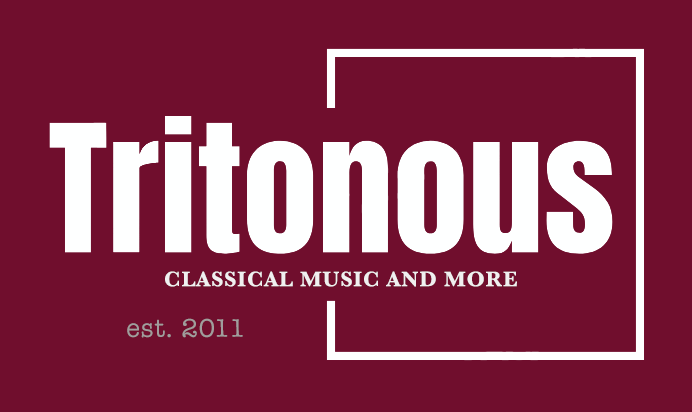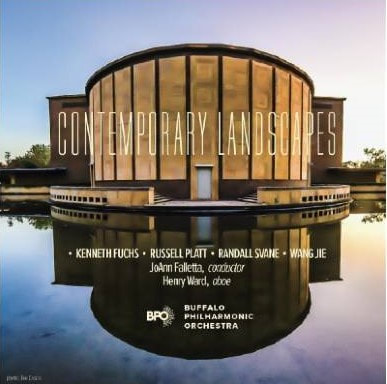And pleasing though it is, frankly it doesn’t really merit two recordings in close succession. Even though it is an inestimable improvement over the drab wind band version (as recorded by the U.S. Coast Guard Band in 2018 for Naxos), the piece itself isn’t one which lends itself to (or needs) much interpretation. It just is what it is, and pretty much speaks for itself. Nonetheless there are slight differences between the two recordings.
First and foremost, Wilson and the Chandos engineers provide a wider dynamic range – the softs are softer, and thus the crescendos swell with a bit more majesty and power. And Wilson’s ear for color is everywhere evident. Meanwhile in Buffalo, the microphones are closer to the musicians and it sounds like there are more of them spread throughout the orchestra (though there is no spotlighting). Falletta tends to bring out the little snippets of melody as they appear here and there (trumpet, then violins), while Wilson is all atmosphere. And thus, the primary difference between the two as I hear it: Falletta is a bit more matter of fact, due in part to the slightly closer recorded perspective, while Wilson goes for color and atmosphere above all else, supported by the sumptuous Chandos sound. Given the circumstances, I wish Falletta had recorded a better piece from Fuchs’ recent output instead – one which would have benefitted from a second interpretation (his Cloud Slant or Light Year, for example).
But what an interesting (and startling!) contrast comes next on the program. Russell Platt’s Symphony in Three Movements is instantly more dynamic and dramatic, and the music much more immersive, innovative and compositionally substantive. The immediacy and sheer presence of the orchestra is in every way more beneficial here than it was in the Fuchs.
The opening Feroce sets the tone with propulsive, driving rhythms and dissonant outbursts – punctuated by trombone glissandos, athletic percussion, and spiky, articulate woodwinds over the top – interspersed with melodic motifs in the strings. For a brief moment, the Rite of Spring came to mind; but No! – it’s Star Wars! And I was all smiles.
The central Chaconne con moto is restless with thematic motifs passed around the orchestra, soon developing into some harmonic hints of Sibelius – before an ominous tune is taken up by the strings, answered by a dissenting solo trombone beneath and a startling bass drum wallop. The finale combines an Adagio, beginning with the entire string section unisono in an anguished furtive lament, and an animated, rhythmic Allegro, which takes flight much like a Scherzo. A brief pastorale interlude near the end leads to a very Walton-esque proclamation from the full orchestra, building to a triumphant conclusion.
This is a fantastic piece of music – endlessly creative and fascinating – brilliantly played by this terrific orchestra. It is mostly tonal (but with moments of deliberate dissonance) and spectacularly orchestrated. The energetic rhythms and melodic content certainly keep the listener engaged in rapt anticipation of what’s coming next. I thought the work often feels more like a “Concerto for Orchestra” than a true Symphony. It features various sections of the orchestra in constant back-and-forth exchanges, as soloists and often in pairs. A variety of woodwinds in animated conversation with silky strings, frequently interrupted by angry brass and percussion – it really is a brilliantly orchestrated showcase for the entire orchestra.
The program continues with a wonderful Oboe Concerto by Randall Svane – with lovely playing of the solo part by Buffalo’s principal oboist, Henry Ward, and colorful, atmospheric support from Falletta. I thought this would be a bit anticlimactic after the unrestrained ruggedness of the symphony, but it wasn’t. It is a wonderful, welcoming respite – soothing on the soul and musically enriching.
This did not start out as a traditional concerto; it is an orchestration of Svane’s Oboe Sonata, made at the request of Ms. Falletta. It is laid out in the traditional 3 movements, “Flowing”, “Very Slow”, and “Quick and Light”. And without going into too much detail, that comes pretty close to what we hear. The opening movement sets out as if to tell a story – descriptive, intriguing and lyrically singing, but with a gentle, restless rhythmic pulse underlying it. Imaginatively orchestrated, it keeps the listener intrigued with glittering color and hints of Bartok sprinkled about. Its exotic tonality, with an almost oriental flavor, is really quite alluring, and Mr. Ward proves to be a superb soloist.
The “Very Slow” movement is mercifully not that slow (likely due to Falletta’s instinctive judgement), and is positively lovely in its pastoral lyricism. Svane wisely keeps it short (3-1/2 minutes), as it is not a striking contrast to the 1st movement. The Finale then, true to its description, is lively and gay – but not for long. The music soon settles back into more of the lyricism we’ve heard before. It does pick up again though, for a thoroughly delightful and charming finish.
I must interject here and note that I was struck by the atmosphere and sheer beauty of sound in this piece – more so than in the Fuchs. Curious, I glanced at the back cover and discovered this was recorded nearly 2 years after the others on this CD – and that likely explains the difference I hear. It is a bit more spacious, atmospheric and colorful, with an airy delicacy to the reverberation. (I’d almost swear it was recorded in a different hall, but the booklet confirms it was not.) The oboe is not at all spotlight, and his tone floats almost ethereally up into the acoustic, which is sheer loveliness.
I enjoyed this piece so much I thought it interesting to compare it with another new American oboe concerto – the one by Bruce Broughton, issued just last year on Naxos (and previously reviewed here on my blog’s “Year in Review” segment). Broughton’s is much more contemporary-sounding – perkier, more jagged and rhythmically propulsive, complete with some innovative orchestral effects. But it’s less instantly gratifying in its tunefulness – less affable, and certainly more “notey”. And the Naxos recording, while being superbly present and immediate, isn’t nearly as alluring as the one in Buffalo. I have come to realize I may have overestimated it after hearing this wonderful creation by Svane.
The concert closes with a single movement work by Wang Jie, “The Winter that United Us”. I found the title rather interesting, and before I listened to a single note, I read in the booklet that she refers (primarily) to the winter of Covid. I personally did not witness the world become united during the pandemic. Just the opposite actually. But I am happy that Ms. Jie found a sense of unification through it all, and I admire her positive perspective.
So does that translate into her music? Well…not really. At least not to these ears. There is certainly a lot of chaos in it, which seems spot on. It’s controlled chaos though, and surprisingly tonal. But I’m not sure I hear it culminating in the comforting assurance of unity. But it really doesn’t matter. Taken strictly as a piece of music, it’s impressive. It starts off with some (almost) too obvious harmonic suggestions of Sibelius, followed by some (almost) too obvious rhythmic references to Stravinsky’s Rite of Spring, followed by lyrical interludes with some (almost) too obvious hints of VW’s The Lark Ascending. And she’s not done yet! The music soon develops into the (almost) too obvious brass-laden rhythmic propulsion and soaring strings of a rousing John Williams soundtrack. And back and forth we go – from driving rhythms to soaring tunes in the strings determined to be heard over rambunctious percussion.
Hearing the unmistakable similarities to other composers in this music (in all new music, actually) is something I enjoy discovering. It makes it interesting and all the more approachable and “friendly”, rather than merely novel and unfamiliar. But there’s no denying it’s all a bit disjointed, perhaps missing a connecting thematic thread to it. But JoAnn Falletta’s mastery at interpreting music (and commanding an orchestra) just manages to hold it all together – taking us along for the ride, with all its unstoppable momentum. And she certainly generates sensational playing from the orchestra. And with spectacular recorded sound, this is a crowd-pleaser for sure. (I can imagine the audience going wild at its conclusion, and I won’t deny I couldn’t help but be dazzled by it.)
Finally, as to the production itself, this is the first recording released on the Buffalo Philharmonic’s own, new label, Beau Fleuve Records, distributed by Naxos. And it is an impressive achievement. The only exception is with the enclosed booklet, which unfortunately was printed with the pages out of order, presenting the composers in a different order from how their music is played on the CD. And the oboist’s bio is misplaced – confusingly sandwiched in between two unrelated composers. After I figured it out though, all was good.
This release appears to be available primarily as a digital download (sigh), but a physical CD can be obtained from the BPO’s website at a reasonable price. This is a marvelous collection of (mostly) new music, brilliantly played and spectacularly recorded – all of it enormously enjoyable.










